


TUBBENDENCE AND SOME OF ITS RESIDENTS
Tubbendence was the name of a large house that stood in 170 acres of land at the far end of Tubbenden Lane from Farnborough Village, just near where the railway bridge by Orpington station was built. It was therefore just within the parish of Farnborough, the boundary of which today runs along Tubbenden Lane as far as the railway. However the house pre-dated the railway by at least two centuries. A small part of its land was taken when the railway was built, and the high embankment must have presented a somewhat unwelcome intrusion into the views from the house to the east. The house was present on Ordnance Survey maps of 1948, but gone by 1960. The estate may have been sold off in two phases, as the houses at the back of the former lands, now the location for Maxwell Gardens, are older than those at the front alongside Tubbenden Lane where now lies Shelley Close. Both of these names recall former owners of the house.
Confusingly, while Tubbendence was the correct spelling, on Ordnance Survey maps it was called Tubbenden (see map below), and some other sources have it different again, for example Tubbendens and Tubbendean. As shown later there was an earlier house on the same site, so the house gave its name to the road, rather than the reverse.
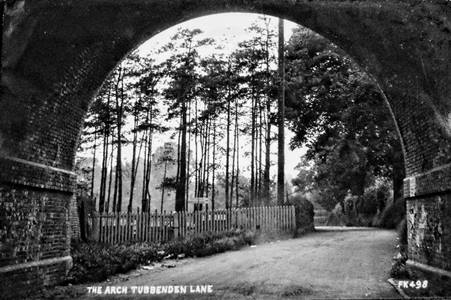 |
|
| Former view from under railway bridge | Milestone and former drive location |
Below is a photo of the main driveway taken from Tubbenden Lane, which runs left to right immediately in front of the camera. The building shown is a gatehouse of some kind. The main house is further along the drive, out of view. The milestone pictured above can be made out to the left of the driveway.
 |
The 1871 map below shows Tubbendence alongside the newly built railway line, opened in 1868. also the Maxwell public house, situated just the other side of the bridge by Orpington railway station, and pictured to the right.
The Maxwell lies at the junction of Crofton Road and Tubbenden Lane, opposite the approach to Orpington station. . There is some uncertainty when the Maxwell Arms was built, some sources state 1887, although the Ordnance Survey map shows it alongside the new railway and the census of 1871 lists a publican and other residents.
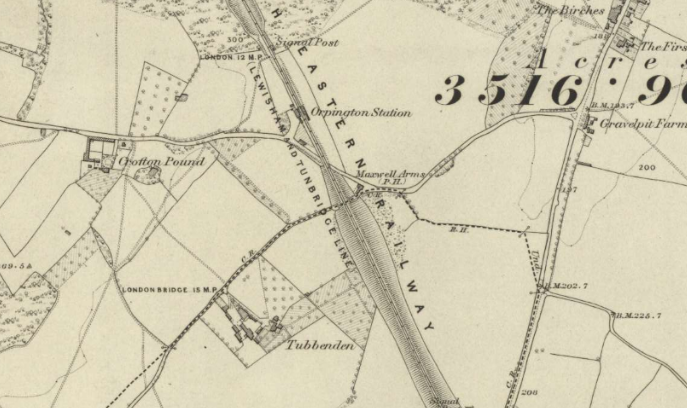 |
 |
The panel to the right contains an historic account of Tubbendence written in the 1880s.. This account almost certainly indicates that the house referred to was not the first on that site, but instead that it replaced an earlier one, as Edward 1st was on the throne in the thirteenth century.
This larger scale map shows the arrangement of buildings and driveways. The milestone referred to above can be seen beside the drive, where it meets Tubbenden Lane.
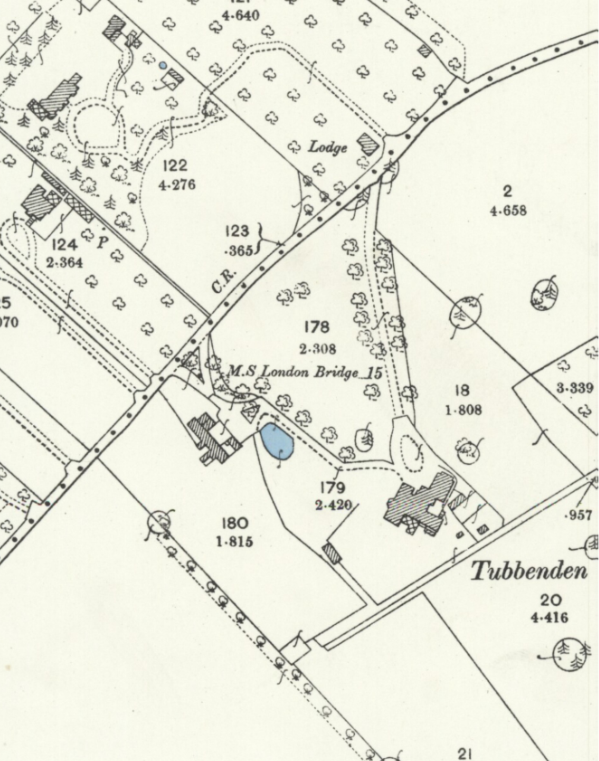
Many former owners or residents are buried at St. Giles, Farnborough, either in the graveyard or in the church itself, and some also have memorial plaques fixed to the church walls.
Here are some of them:
George DaltonGeorge Dalton, a benefactor, was buried on 11th January 1566. In his Will he left ten shillings to be paid for a sermon to be preached at Farnborough parish church, annually, and 3s 4d to be given to the poor of the parish for ever. The register does not say how he died, but there is a legend that he used to arrive at his house at ‘Tubbendence’ drunk. One night his wife refused to admit him. He wandered off. fell into a lake and was drowned . In my opinion, this sensational event in the village would have meant some comment in the register if true.Fred Whyler, part of ‘Farnborough Parish Registers 1538 – 1652’, Bromley Borough Local History Society June 1997 |
|
And this is from the St. Giles church website, taken from the original St. Giles Guidebook:
On the South wall of the nave next to the gallery, is the painted board commemorating the Benefaction of George Dalton to the parish in 1566.
To this day, the "Rush Sermon" is still preached on the appropriate day, the floor of the nave being strewn with cut flags (wild Iris), leaves and other herbs
The Maxwells
On the South
wall of the Chancel in St. Giles church is a plaque commemorating James
Primrose Maxwell, and his wife Anna Maria. She died in 1832, aged 60,
and her husband 7 years later aged 76. James was recorded as
‘Gentleman’, and his address as Harley Street, London. The wording on
the plaque implies that the remains of both were deposited in the
church, presumably under the floor. Neither is recorded in the
documentation for the graveyard, although their dates of death were
before Farnborough became a full parish and also before the ‘new’
graveyard was laid out. Documentation for the original graveyard round
the church is known to be incomplete. It would seem from the historical account earlier that the house passed to James Primrose Maxwell through marriage. Not much is known about James Primrose Maxwell, although as his main address is given as Harley Street in London it can probably be assumed that he had a medical background.
James and Anna Maria had three children
Eliza Maxwell 1785 – 1853;
Captain George Berkeley Maxwell, 1791 – 1854, and
Emily, whose details are not recorded, so may have died in childhood.
Eliza Maxwell married Thomas Young and they in turn became the owners of Tubbendence, see below.
George, their second child, had a distinguished naval career. He did not retain a local connection, but further information has been kindly supplied by Shelagh Mason as follows:
George Berkeley Maxwell was baptised 15th February 1791, as. of James Primrose Berkeley and Ann, at St. Thomas, Portsmouth, Hampshire. Father James Primrose Berkeley was living with his son in Harley Street, but was buried at St. Giles, Farnborough, Kent on 22nd July 1830, aged 76 (n. 1754, possibly Holborn, London).
George Berkeley Maxwell married Laetitia Clerk 23rd April 1821 (location unknown). Their known children were::
Annetta Latitia was baptised 19th Sep 1822 at St. Mary, Harkstead, Suffolk. Note: Born 13th August at Lausanne, Switzerland. Stuart
John Mildmay Maxwell was baptised 7th April 1834 in the British Chaplaincy in Rome, Italy. George Shirley Maxwell was baptised 16 May 1831;
Emily 12 Apr 1836 and Emily Jane 28 May 1838 – all at St. Marylebone, Middlesex.
|
|
|
| James Primrose Maxwell | Thomas Young |
Thomas Young
Thomas Young had a very distinguished life and there is a further plaque commemorating both Thomas and Eliza Young in St. Giles church, above right.There are many biographical accounts of the life and achievements of Thomas Young available online. His Wikipedia entry reveals that while he was praised by many including Sir John Herschel and Albert Einstein, he sometimes had difficulty in communicating his knowledge. It was said by one of his contemporaries that, "His words were not those in familiar use, and the arrangement of his ideas seldom the same as those he conversed with. He was therefore worse calculated than any man I ever knew for the communication of knowledge." However the following is taken from a short article from before the internet age, published in the magazine of the Bromley Borough Local History Society in January. 1976.
Thomas Young was described as a man eminent in almost every department of human learning and he was regarded as the most learned man of his generation. He was born at Milverton, Somerset, on 13 June, 1773; the eldest son of Thomas Young, by his wife Sarah, the eldest daughter of Robert Davies of Minehead. On 14 June 1804, when he was 31 years of age, Thomas Young married Eliza, who was then 19, and was the second daughter of James Penrose Maxwell, who had a residence at Tubbendens near Farnborough. This was a branch of the family of Sir William Maxwell of Calderwood Castle Lanarkshire.
| Thomas Young has a memorial in Westminster Abbey, where he is described as being endowed with the faculty of intuitive perception, and bringing an equal mastery to the most abstruse investigations of letters and science. His theory of the wave motion of light influenced the current thought of mathematical physics during the whole of the 19th century. He helped in the preparation of early editions of the Encyclopaedia Britannica, and the then editor said '/' ’J the work was largely indebted in almost every respect which it embraced, to his profound and accurate knowledge, rare erudition and other various attainments. |
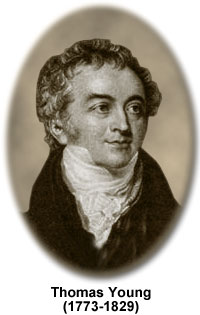 |
Young was a Fellow and Foreign Secretary of the Royal Society and a member of the National Institute of France. He set his ingenious mind to solve the riddle of the Rosetta stone. He was convinced that the three sets of hieroglyphics on the stone contained the same message, and after four years study he determined nearly one hundred of the characters and thus helped his French friend Champollion to determine twice as many more, so solving the great riddle of the stone and the obscurity which for centuries had veiled the writings of the ancient Egyptians.
Thomas Young's marriage was a particularly happy one and he attached himself to his wife's family with great affection. His wife had three sisters, Maria Emily and Caroline, and the Maxwell family were described as being accomplished and agreeable. Young and his wife spent much of their time with the family at Tubbendens. He died at his home at Park Square. London, on 10 May 1829 about a month before his 56th birthday. He left no issue. His wife lived a further 30 years and died in 1859.
Sir Francis Henry Evans
Francis Evans was born on the 29th August, 1840. He
adopted the engineering profession and obtained his practical training
under Sir James Brunlees, under whom he was employed on railway
construction at home and in South America. After spending some time in
the United States, he returned home and decided to relinquish the
pursuit of engineering and to devote his attention to banking. His firm
was known as Melville, Evans and Company, and its operations were
largely between this country and America. In 1872 he married Marie de Grasse, daughter of the late Hon. Samuel Stevens, of Albany, U.S.A., and widow of Mr. Irving Van Wart. They had three sons and two daughters.
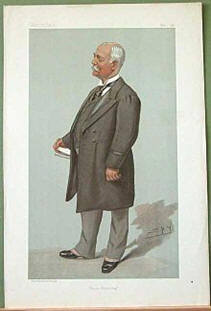 |
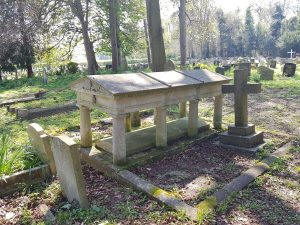 |
In 1880 he took a prominent place in shipping circles as deputy-chairman of the Union Steamship Company, under Mr. Alfred Giles, Past-President of The Institution, whom he subsequently succeeded as chairman, becoming also managing- director of the company. When the Union Steamship Company was amalgamated in 1900 with the Castle Line, it was Sir Francis Evans who carried through the difficult and important financial details of the transaction on behalf of the Union Company, Sir Donald Currie representing the Castle Line. On its completion, Sir Francis Evans joined the firm of Donald Currie and Company, the managers of the Union-Castle Line, and remained a member of it until his death. He was also a director of the International Sleeping Car Company, the Thames and Mersey Marine Insurance Company, and was chairman of the Ely& Palace Hotel in Paris.
For services rendered to the Government of Newfoundland in connection with the fishery dispute with France, and for other colonial services, he was made a K.C.M.G. in 1893. In 1902 he was created a baronet.
In politics he was a Liberal, and was elected four times to represent the constituency of Southampton in Parliament. In 1900 he was returned at a by-election for Maidstone, which he continued to represent until the general election of 1906. He died of angina pectoris, aged 66 on the 22nd January 1906 at his London residence, 40 Grosvenor Place. However, his main residence was Tubbendence.
He is buried in the grave in the churchyard at St. Giles Farnborough, shown above, along with his wife Marie who died in 1920.
Nick Reynolds
THE LOCAL AREA
The Chicken Years and Beyond
Unfortunately, like so many of the grand houses in the borough, Tubbenden had a rather sad end.Not long before the First World War the estate became the business premises of William Henry Cook who, following in his father’s footsteps, bred the famous Orpington Buff chicken and exported it all over the world.
He was in “acrimonious rivalry” with his sister Elizabeth Jane Taylor, who continued to run her chicken business at the original premises in St Mary Cray.
Elizabeth Jane’s business went into liquidation in 1935 but William Henry carried on trading at Tubbenden until his death in 1947. Cook, however, did not run his business from the main house but from the Lodge House. The main house was split into “high class” flats.
The Girl Guides used Cook’s field for camping in the 1920s and Orpington Cricket club played there. In the 1920s the manager at the farm was Harry Cousins and in the 1980s his widow Alice recalled in the Kentish Times: “Tubbenden House was filled with gentry when we left in the 1920s and it went on as flats for some time. People with lots of money, millionaires and their fancy ladies. “There were grand parties and socialising in the flats … this may have given rise to the rumour the house was used for dances.” One has to wonder what was wrong with them holding dances!
During the war the house became a refuge for Londoners bombed out of their homes —as did other big properties in Tubbenden Lane — and eventually as the property deteriorated it was used for storing furniture for the homeless until it was demolished in the 1950s, house and grounds making way for a housing estate.
Christine Hellicar
An Historic Account
This account appears in Chapter X111 of 'Village London' Vol 2, published by The Alderman Press March 1984 but first published 1883-4 by Cassell & Co Ltd., under the title 'Greater London'.Tubbendens is another ancient seat in this district, the demesnes of which lie partly in this parish and partly in that of Orpington. In the twenty-first year of Edward I it was possessed by owners of the same name, as it appears that ”Gilbert Saundre of Orpington, demised several parcels of land to John de Tubbendens, of Ferneborough, and his sons.” According to Hasted, “in 1660 W. Gee conveyed it to Thomas Brome, serjeant-at-law. His arms are in one of the windows of Gray’s Inn Hall. He resided at Tubbendens and died in 1673, and was buried in Farnborough Church. He was succeeded by his son, William Brome, barrister-at-law, whose son, Colonel John Brome succeeded him. Both were buried in Farnborough Church.” Colonel John Brome married Elizabeth, only child of the Rev. George Berkeley, Prebendary of Westminster, second son of George, first Earl of Berkeley. Their daughter Maria married a Mr John Hammond, of Chatham, who in right of his wife, became the owner of Tubbendens, of which he died possessed in 1774, leaving two daughters, one of whom, Anna Maria, married James Primrose Maxwell, whose grandson, Colonel George Shirley Maxwell, now owns the estate. It will thus be seen that Tubbendens has passed from one generation to another, either in male or female descent, for upwards of 200 years. From an old book, entitled “Stemmata Chicheleyana” it appears that through the Bromes and Berkeleys the present owner of Tubbendens is descended from the father of Archbishop Chicheley, who died in the year 1400.
The present house dates from the seventeenth century, but has of late years been partially rebuilt and modernised. The estate, comprising about 170 acres, has this much of interest attached to it: that it has remained the same in extent for centuries past, except when a small portion was taken by the South Eastern Railway to construct the chalk embankment on which stands the Orpington Station. At the entrance gate of Tubbendens is a milestone over a century old, marking fifteen miles from London Bridge.